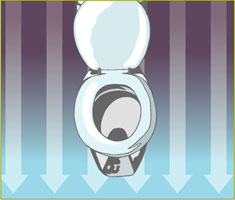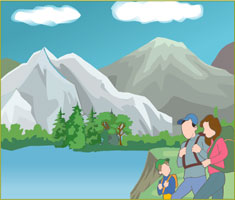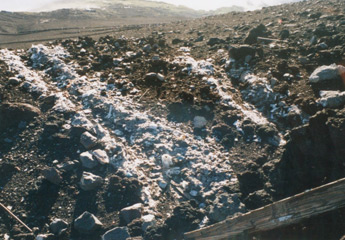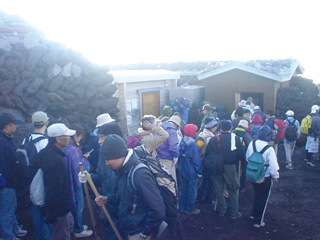Human Waste Treatment in Natural Areas



- This is the technology to appropriately dispose human waste in areas where construction of infrastructures including water supply and sewerage systems, commercial power supplies, and roads is not sufficient, such as mountain districts,and where natural environment conservation must be considered.
- This technology differs from general human waste disposal in that wash water and human waste treated wastewater are not discharged into public water areas in principle, considering natural environment conservation.
- Because treated wastewater is not discharged, this treatment technology falls under vault toilets defined in the Building Standards Act, not under water-purifier tanks defined in the Private Sewerage System Act.
Reference
Reference: What are water-purifier tanks?
- (Article 2 item 1 of the Private Sewerage System Act)
- Equipment or facilities connected to toilets to treat human waste and other wastewaters (excluding special wastewaters such as industrial wastewater and rainwater: ditto with the followings) and to discharge them into a place or facility other than public sewers having a terminal treatment plant defined in Article 2 item 6 of the Sewerage Service Act (Law No. 79 of 1958) (hereinafter referred to as “terminal treatment sewers”), excluding human waste treatment facilities built by municipalities according to a plan defined under the provision of Article 6 item 1 of the Law on the Treatment and Cleaning of Public Sewers, River Basin Sewerage Systems, and Waste (Law No. 137 of 1970) defined in the act
Reference: What are vault toilets?
- (Article 31 of the Building Standards Act)
- In treatment areas defined in Article 2 item 8 of the Sewerage Service Act (Law
No. 79 of 1958), toilets other than flush toilets (the ones whose soil pipe is connected to the public sewer defined in Article 2 item 3 of the Building Standards Act) must not be
used.
If human waste from a toilet is discharged into a place or facility other than public sewers having a terminal treatment plant defined in Article 2 item 6 of the Sewerage Service Act, a septic tank must be provided (whose structure meets the technical standards defined in the government ordinance as to its human waste treatment performance (the one required for septic tanks to treat the waste without causing any hygienic problems), and which adopts the structural mechanism defined by the Minister of Land, Infrastructure and Transportation, or which has been accredited by the minister).
Human Waste Problem in Natural Areas


- Since power and water supply systems had not been constructed enough generally in mountain districts, human waste was disposed by digging a hole, putting it in, and having it permeate into soils. In areas having no toilet, evacuation was done outdoor
- On the other hand, as many people come to visit mountain districts by a recent mountaineering boom, a concern about the effects of human waste on water quality in public water areas and on plants is growing.
- Against the background of these growing calls, mountain hut operators and local governments began efforts to improve human waste disposal. In addition, equipment that does not discharge wash water and treated water has been rapidly developed and commercialized.
- To reduce the effect of human waste in natural areas where infrastructures have not been developed, voluntary efforts including adoption of these technologies is expected.
Types of Human Waste Treatment in Natural Areas
| Large classification (necessity of water) |
Small classification (treatment method) |
Characteristics | Pretreatment | Technical explanation |
| Necessary (water washing) |
Biological treatment |
Soil | Necessary | Treat it using adsorption and filtration by soil particles and soil microbes (simplified water washing). |
| Treat it using a bio-film and soil microbes (simplified water washing). | ||||
| Drug addition | Necessary | Add a drug as biological treatment adjuvant. | ||
| Add an enzyme drug as biological treatment adjuvant. | ||||
| Oyster shell | Necessary | Treat it with a bio-film using oyster shells as a contact agent. | ||
| Membrane | Necessary | Treat it with activated sludge, and then perform solid-liquid separation with a membrane. | ||
| Wood | Necessary | Spray wastewater on wood chips, a contact agent, and then treat it with a bio-film. | ||
| Plastic | Necessary | Treat it with a bio-film using plastic as a contact agent (described as a reference case). | ||
| Ozone | Necessary | Treat it by contact aeration, and then with ozone. | ||
| Chemical treatment |
||||
| Physical treatment |
Drying/ incineration |
Not necessary |
Dry and incinerate it for powderization (described as a reference case). | |
| Not necessary |
Biological treatment |
Wood | Not necessary |
Put it in a wood-base contact agent, and treat it by supplying air and stirring it. |
| Chemical treatment |
||||
| Physical treatment |
Drying/ incineration |
Not necessary |
Dry and incinerate it for powderization (described as a reference case). | |
- *’ - ’ will be added when it becomes an target verification technology.
- * This technical classification table is classified according to technical characteristics in the ETV Project, not from an academic point of view.
- * Pretreatment means a process to facilitate the next treatment, such as prior separation of solid matters and liquefaction for accelerating decomposition by microbes.